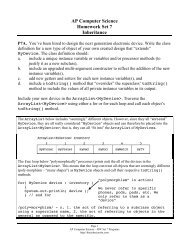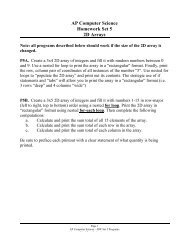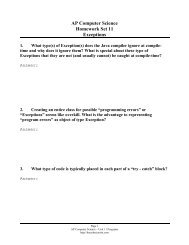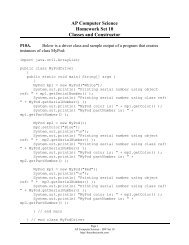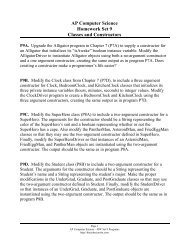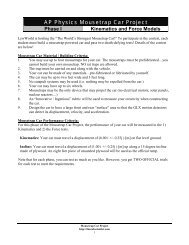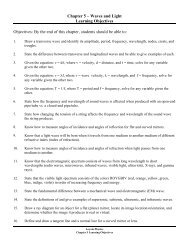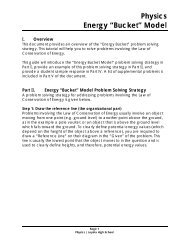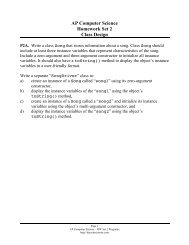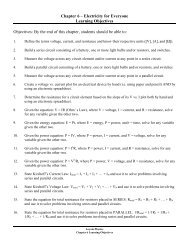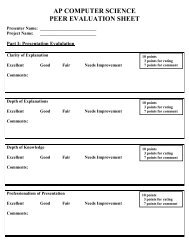Physics Momentum “Bucket” Model - thecubscientist.com
Physics Momentum “Bucket” Model - thecubscientist.com
Physics Momentum “Bucket” Model - thecubscientist.com
Create successful ePaper yourself
Turn your PDF publications into a flip-book with our unique Google optimized e-Paper software.
<strong>Physics</strong><br />
<strong>Momentum</strong> <strong>“Bucket”</strong> <strong>Model</strong><br />
I. Overview<br />
This document provides an overview of the “<strong>Momentum</strong> Bucket” problem<br />
solving strategy. This can be introduced during Chapter 1, Activity 8<br />
“Concentrating on Collisions” to aid students in solving problems involving the<br />
Law of Conservation of <strong>Momentum</strong>. These types of problems usually involve a<br />
collision between two or more objects either of which may be moving before<br />
and/or after the collision.<br />
This guide will introduce the “<strong>Momentum</strong> Bucket <strong>Model</strong>” problem solving<br />
strategy in Part II, provide an example of this problem solving strategy in Part III,<br />
and provide a student sample response in Part IV. A list of supplemental<br />
problems is included in Part V of the document.<br />
II. <strong>Momentum</strong> <strong>“Bucket”</strong> <strong>Model</strong> Problem Solving Strategy<br />
A problem solving strategy for addressing problems involving the Law of<br />
Conservation of <strong>Momentum</strong> is given below.<br />
Step 1: Statement of Conservation of <strong>Momentum</strong><br />
This step requires the student to state the Law of Conservation of <strong>Momentum</strong>:<br />
pi = pf. Although a small step, it requires the student to state which model he will<br />
be using.<br />
Step 2: Define the positive direction (the organizational part)<br />
Since momentum is a vector quantity, it is important to define the positive<br />
direction for motion, especially when the two objects in motion are moving in<br />
opposite directions. The direction for the positive direction is arbitrary, but in this<br />
document the positive direction will be defined to be towards “right” or the<br />
direction consistent with the positive x-axis as defined in Algebra I classes.<br />
Page 1<br />
<strong>Physics</strong> | Loyola High School
Step 3: Draw <strong>Momentum</strong> Buckets<br />
The concept of Conservation of <strong>Momentum</strong> requires the student to analyze the<br />
INSTANT BEFORE the collision and the INSTANT AFTER the collision. Here students<br />
fill each “momentum bucket” depending on whether or not each object is<br />
moving (i.e. possesses momentum). There are three possible cases. Each is<br />
described below:<br />
Case I: One or both objects are traveling in the positive direction BEFORE the<br />
collision; one or both objects is traveling in the positive direction AFTER the<br />
collision. In the case shown below, both m1 and m2 are traveling to the right<br />
before the collision, only m2 is moving after the collision.<br />
Before collision<br />
After collision<br />
v1i v2i v2f<br />
m1 m2 m1<br />
m2<br />
+<br />
= +<br />
pm1<br />
in<br />
pm2<br />
pm2<br />
The “i” and “f” subscripts represent the “initial” and “final”, representing the<br />
instant before and after the collision, respectively.<br />
m1 = the mass of object 1 [kg]<br />
v1i = the velocity of object 1 at the instant BEFORE the collision [m/s]<br />
v1f = the velocity of object 1 at the instant AFTER the collision [m/s]<br />
m2 = the mass of object 2 [kg]<br />
v2i = the velocity of object 2 at the instant BEFORE the collision [m/s]<br />
v2f = the velocity of object 2 at the instant AFTER the collision [m/s]<br />
p = the momentum of the object [kg m/s]<br />
Page 2<br />
<strong>Physics</strong> | Loyola High School
Case II: One or both objects are traveling in the positive OR negative direction<br />
(i.e. backward) BEFORE the collision; one or both objects is traveling in the<br />
positive OR negative direction AFTER the collision. In the case shown below,<br />
both m1 and m2 are traveling to the right initially, only m2 is moving after the<br />
collision. Note that a velocity in the negative direction is denoted by an “upsidedown”<br />
bucket.<br />
Before collision<br />
After collision<br />
m1<br />
v1i v2i v1f<br />
v2f<br />
m2<br />
m1<br />
m2<br />
+<br />
= +<br />
pm1<br />
pm2<br />
-pm1<br />
pm2<br />
in<br />
Page 3<br />
<strong>Physics</strong> | Loyola High School
Case III: One or both objects are traveling in the positive OR negative direction<br />
(i.e. backward) BEFORE the collision. However, after the collision, the two objects<br />
lock/stick together and travel in the same direction (which may be positive or<br />
negative). In the case shown below, both m1 and m2 are traveling to the right<br />
initially, and after the collision they “lock” or “stick” together and move off with<br />
a <strong>com</strong>mon velocity represented with vf.<br />
Before collision<br />
After collision<br />
v1i v2i vf<br />
m1 m2 m1 m2<br />
+<br />
=<br />
pm1<br />
in<br />
pm2<br />
pm1+m2<br />
Page 4<br />
<strong>Physics</strong> | Loyola High School
Step 4: Write Conservation of <strong>Momentum</strong> Equation<br />
Based on the buckets that were drawn for each case, the corresponding<br />
conservation of momentum equation can be written. The “momentum buckets”<br />
for each case are redrawn below for convenience.<br />
Case I: Two objects are moving to the right before the collision. After the<br />
collision, one object stops and the other continues to travel to the right.<br />
+<br />
=<br />
m1v1i + m2v2i =<br />
m2v2f<br />
Case II: Two objects are moving to the right before the collision. After the<br />
collision, one object “rebounds” and travels to the left. The other object<br />
continues to move to the right. Note the negative momentum for the objects<br />
that “rebounds” and travels to the left.<br />
+ =<br />
+<br />
m1v1i<br />
+ m2v2i -m1v1f +<br />
=<br />
m2v2f<br />
Case III: Two objects are moving to the right before the collision. After the<br />
collision, the objects stick together and move off with a <strong>com</strong>mon velocity.<br />
+<br />
=<br />
m1v1i<br />
+ m2v2i = (m1+m2)vf<br />
Step 5: Solve (the mathematical part)<br />
After <strong>com</strong>pleting Step 4, the conservation of momentum equation for that<br />
situation will be written. Given information for all but one variable, algebra can<br />
be used to solve for the remaining variable. As mentioned above, this step is a<br />
purely mathematical step, using math as a tool to arrive at the correct answer.<br />
The following section models how this strategy can be used to solve a<br />
Conservation of <strong>Momentum</strong> problem.<br />
Page 5<br />
<strong>Physics</strong> | Loyola High School
Part III. Example Conservation of <strong>Momentum</strong> Problem<br />
Two trains are on a track. The mass of Train 1 is 1000 kg and the mass of Train 2 is<br />
2500 kg. Train 1 is moving with a velocity of 20 m/s to the right. Train 2 is initially<br />
at rest. The two trains collide and after the collision Train 1 continues to move to<br />
the right but at 10 m/s. The trains do not couple with one another. (a) What is the<br />
velocity of Train 2 after the collision? (b) If Train 1 instead rebounds with a<br />
velocity of 5 m/s after the collision (i.e. moves backward), what is the velocity of<br />
Train 2 after the collision, (c) If the trains DO couple with one another after the<br />
collision, with what <strong>com</strong>mon velocity do they move off together with?<br />
Given:<br />
v1i v2i v2f<br />
Train 1 Train 2 Train 1<br />
Train 2<br />
Find: a) vTrain2 after collision if Train 1 continues to move forward<br />
b) vTrain2 after collision if Train 1 rebounds<br />
c) vTrain1+2 after collision if Train 1 and Train 2 couple together upon collision<br />
Solution:<br />
PART A:<br />
1. Statement of Conservation of <strong>Momentum</strong><br />
pi = pf<br />
2. State positive direction<br />
Positive direction is to the right<br />
+<br />
3. Draw <strong>Momentum</strong> Buckets<br />
+ +<br />
=<br />
pTrain1<br />
pTrain1<br />
pTrain2<br />
4. Write Conservation of <strong>Momentum</strong> equation<br />
5. Solve<br />
v<br />
2 f<br />
m1v1i = m1v1f + m2v2f<br />
m v<br />
( 1000)( 20) ( 1000)( 10)<br />
! m v<br />
!<br />
1 1i<br />
1 1 f<br />
= = =<br />
m<br />
2<br />
2500<br />
4[ m / s]<br />
Page 6<br />
<strong>Physics</strong> | Loyola High School
The positive answer implies the Train 2 travels in the positive direction, that is, to<br />
the right.<br />
PART B:<br />
1. Statement of Conservation of <strong>Momentum</strong><br />
pi = pf<br />
2. State positive direction<br />
Positive direction is to the right<br />
+<br />
3. Draw <strong>Momentum</strong> Buckets<br />
+ +<br />
=<br />
pTrain1 -pTrain1 pTrain2<br />
4. Write Conservation of <strong>Momentum</strong> equation<br />
5. Solve<br />
v<br />
2 f<br />
m1v1i = -m1v1f + m2v2f<br />
2<br />
( 1000)( 20) ( 1000)( 10)<br />
m1v<br />
1i<br />
+ m1v<br />
1 f<br />
+<br />
= = = 12[ m / s]<br />
m<br />
2500<br />
The positive answer implies the Train 2 travels in the positive direction, that is, to<br />
the right. Note that train 2’s velocity is greater than in part (a). The fact that Train<br />
1 “rebounds” implies that there was a greater force here than in part (a),<br />
resulting in a greater change in momentum. This could be due to the physical<br />
makeup (i.e. material) that the objects are made of.<br />
Page 7<br />
<strong>Physics</strong> | Loyola High School
PART C:<br />
1. Statement of Conservation of <strong>Momentum</strong><br />
pi = pf<br />
2. State positive direction<br />
Positive direction is to the right<br />
+<br />
3. Draw <strong>Momentum</strong> Buckets<br />
+ =<br />
pTrain1<br />
pTrain1+ Train1<br />
4. Write Conservation of <strong>Momentum</strong> equation<br />
5. Solve<br />
m1v1i = (m1+m2)vf<br />
v<br />
2 f<br />
m v<br />
( 1000)( 20)<br />
= 1 1i<br />
= =<br />
m<br />
+ m (1000 + 2500)<br />
1 2<br />
5.71[ m / s]<br />
The positive answer implies the Train 1+2 travel in the positive direction, that is, to<br />
the right.<br />
Page 8<br />
<strong>Physics</strong> | Loyola High School




